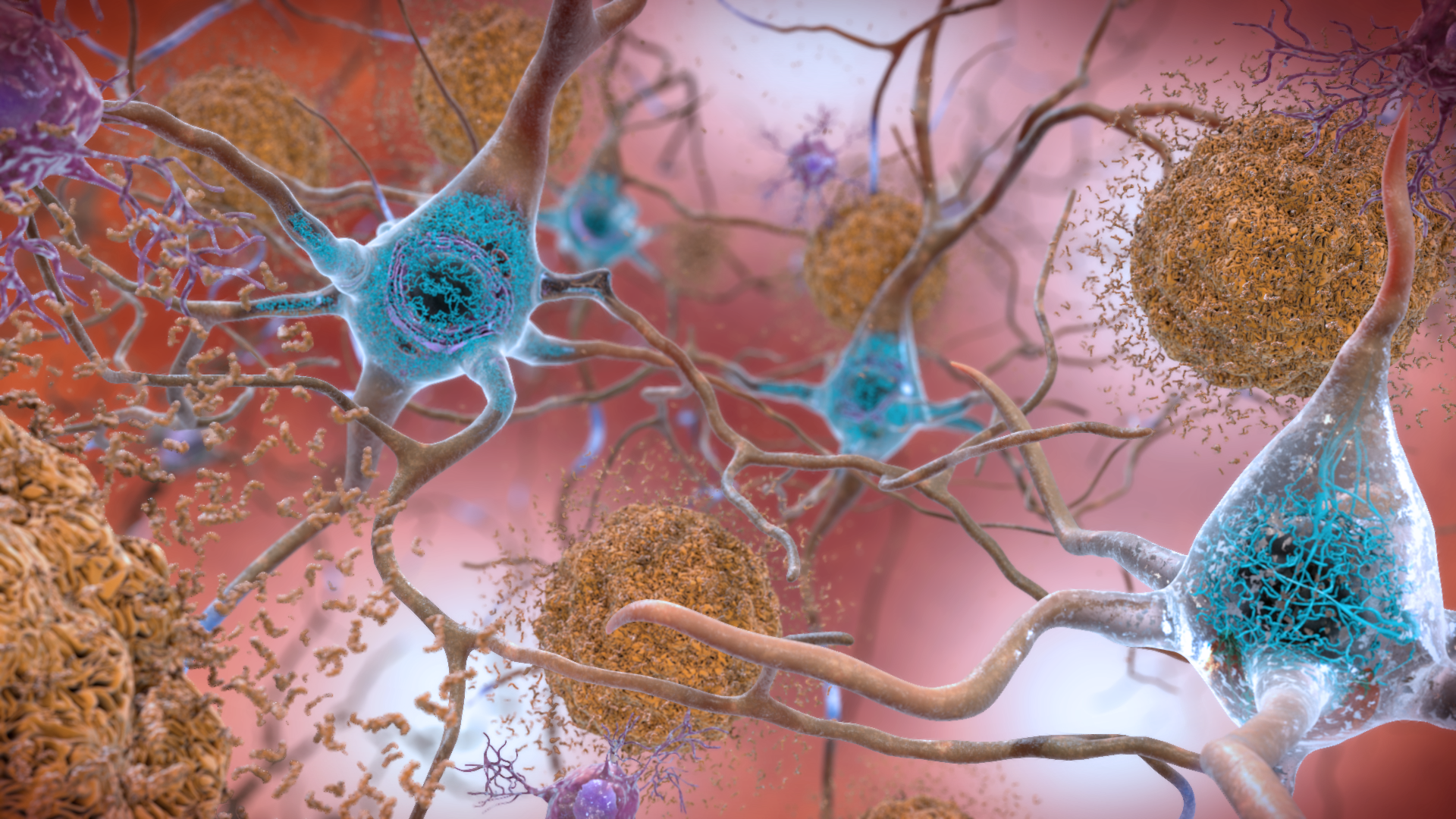CRISPR nanoparticles are the next big hope in Alzheimer’s disease treatments
It’s hard to ignore the fanfare. CRISPR and other genome-editing technologies are set to redefine the way we treat a vast array of illnesses, from cancer to inherited genetic conditions. Hailed as the biggest biotech discovery of the century, CRISPR is enabling an exciting prospect: the ability to cure disease by directly and permanently modifying the human genome.

Naturally, there is a new wave of optimism that this technology can be leveraged towards a potential therapeutic for Alzheimer’s disease. Fueling this notion is CRISPR’s tangible impact on accelerating breakthroughs in Alzheimer’s research in the last five years. With access to this relatively cheap and easy to use technique, neuroscientists are now able to quickly identify new molecular pathways and design more elegant animal models to study neurodegenerative disorders.
Still, experts say that gene modification technologies alone are unlikely to translate into a solution for Alzheimer’s patients anytime soon, given the field’s bleak history of disappointment. A whopping 99.6% failure rate for new Alzheimer’s drugs, hundreds of failed clinical trials, billions of investment dollars lost. There are more questions than answers. Consequently, almost 6 million Americans live with Alzheimer’s – all without solid diagnostic, preventative, or treatment options.
Creating a CRISPR approach to treating diseases of the central nervous systems in humans poses several unique challenges. For one, the brain’s anatomical location and highly sensitive nature make drug administration tricky (and risky) business. Neuroscientists are faced with a conundrum: how to safely inject CRISPR into patients, shuttle it across the notorious blood-brain barrier, and target specific neurons, deep within the cerebrum?
On top of this, a far more fundamental dilemma exists - getting CRISPR into cells on a molecular level.
In order to make tweaks to faulty genes, CRISPR’s machinery (short RNA strands coupled with bulky Cas9 enzyme molecules) needs to cross the cell’s membrane, traverse the intricate intracellular space, dodge organelles, and eventually wind up inside the nucleus, where the genome is, to work its magic.
To do this, therapeutic developers have tried everything from zapping cells with electricity to using disarmed viruses to haul in the gene-editing cargo, all with mixed results and, unsurprisingly, considerable safety concerns. Erring on the side of caution, the FDA has approved only one CRISPR therapeutic to date. This cancer treatment, for which U.S. clinical trials started in May, uses an inactivated HIV strain to deliver CRISPR to the patient’s immune cell.
In March, a team of Korean researchers announced they have developed the nanoparticle equivalent of delivery drones for transporting CRISPR to brains with Alzheimer’s. Their findings were published in the journal Nature Neuroscience.
Biomedical engineer Jongpil Kim and his team created “nanocomplexes” for neurons - molecular bubble wrap used to encapsulate CRISPR components to specifically turn off the Bace1 gene. Bace1 is a prime therapeutic target, as it is known to stimulate amyloid beta (Aβ) production, which in turn has been linked to Alzheimer’s devastating cognitive effects.
Injecting these nanocomplexes into mice (genetically-modified to mimic the biological characteristics of the disease) was found to have remarkable effects. Not only did Bace1 and Aβ levels plummet in Alzheimer’s mice following a single dose, but memory and learning also dramatically improved compared to their untreated counterparts.
“It took a long time to collect the results from the Alzheimer’s mouse models,” says Kim, with longitudinal studies spanning a period of over three months, “but the most exciting moment was seeing the consistent and effective results.”
Still, with much of the genetic landscape around Alzheimer’s development being uncharted territory, an effective CRISPR delivery system alone will not be enough.
“Our scientific understanding of the brain and its disorders is not as advanced as other physiological systems,” says Troy Rohn, biology professor specializing in Alzheimer’s research at Boise State University. “Designing therapeutics where the molecular targets are not well defined is an obvious hurdle that we have yet to overcome.”
Several other technical wrinkles also need to be smoothed out if CRISPR is to live up to its hype. Of these, specificity and accuracy of the system remain major concerns. What are the chances of it making an error while editing a tiny fragment of our 3-billion-letter genome? Also, what are the consequences of those errors, especially considering all changes are permanent?
Speaking to the possibility of a CRISPR nanocomplex gene therapy in the near future, Kim says, “We need to test potential off-target effects extensively in the brains of higher primates first before we can translate our research to the clinic.” New computer software developed for predicting CRISPR’s precision in cells can also aid in endeavors to ensure safety prior to human trials.
Realistically, the odds of an Alzheimer’s cure being forged out of innovations in genetic technology, sadly, remain exceedingly slim. Still, CRISPR’s tremendous contributions to Alzheimer’s research drive progress and continue to inspire even a little bit of hope.
As Rohn optimistically reflects, “I believe this technique has the potential to be the most important tool in medicine for the next 50 years.”
This story originally appeared on Massive Science, an editorial partner site that publishes science stories by scientists. Subscribe to their newsletter to get even more science sent straight to you.
Enjoy reading ASBMB Today?
Become a member to receive the print edition four times a year and the digital edition monthly.
Learn moreGet the latest from ASBMB Today
Enter your email address, and we’ll send you a weekly email with recent articles, interviews and more.
Latest in Science
Science highlights or most popular articles

Bacteriophage protein could make queso fresco safer
Researchers characterized the structure and function of PlyP100, a bacteriophage protein that shows promise as a food-safe antimicrobial for preventing Listeria monocytogenes growth in fresh cheeses.

Building the blueprint to block HIV
Wesley Sundquist will present his work on the HIV capsid and revolutionary drug, Lenacapavir, at the ASBMB Annual Meeting, March 7–10, in Maryland.

Gut microbes hijack cancer pathway in high-fat diets
Researchers at the Feinstein Institutes for Medical Research found that a high-fat diet increases ammonia-producing bacteria in the gut microbiome of mice, which in turn disrupts TGF-β signaling and promotes colorectal cancer.

Mapping fentanyl’s cellular footprint
Using a new imaging method, researchers at State University of New York at Buffalo traced fentanyl’s effects inside brain immune cells, revealing how the drug alters lipid droplets, pointing to new paths for addiction diagnostics.

Designing life’s building blocks with AI
Tanja Kortemme, a professor at the University of California, San Francisco, will discuss her research using computational biology to engineer proteins at the 2026 ASBMB Annual Meeting.

Cholesterol as a novel biomarker for Fragile X syndrome
Researchers in Quebec identified lower levels of a brain cholesterol metabolite, 24-hydroxycholesterol, in patients with fragile X syndrome, a finding that could provide a simple blood-based biomarker for understanding and managing the condition.

